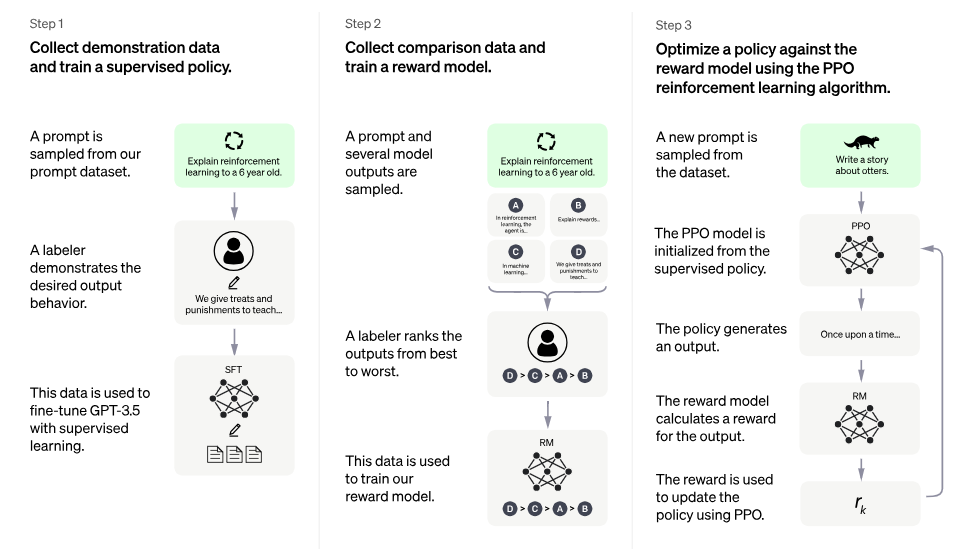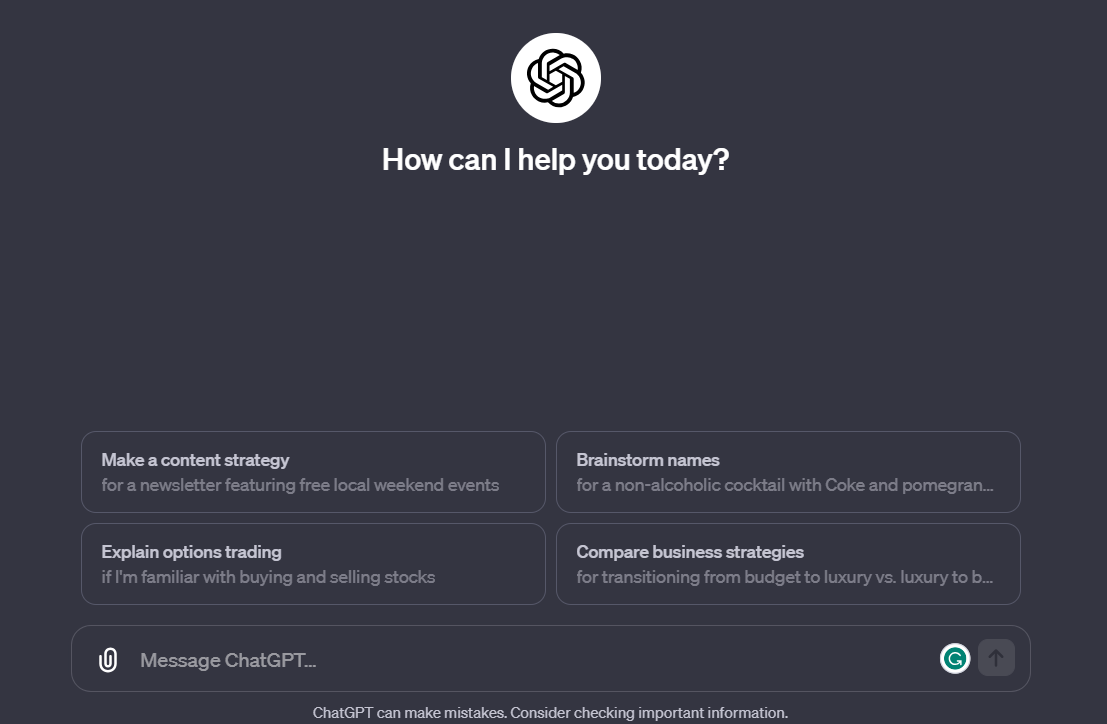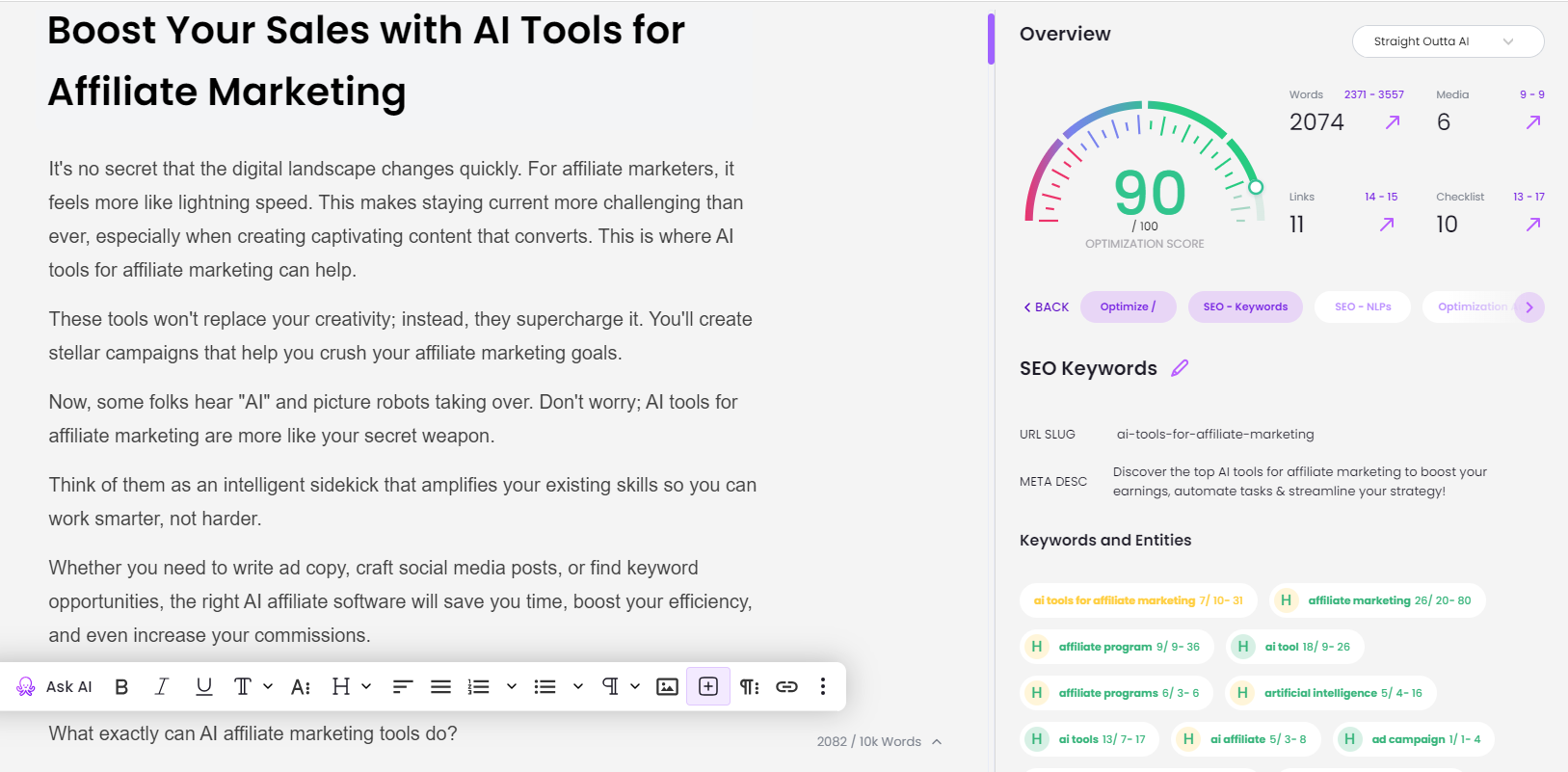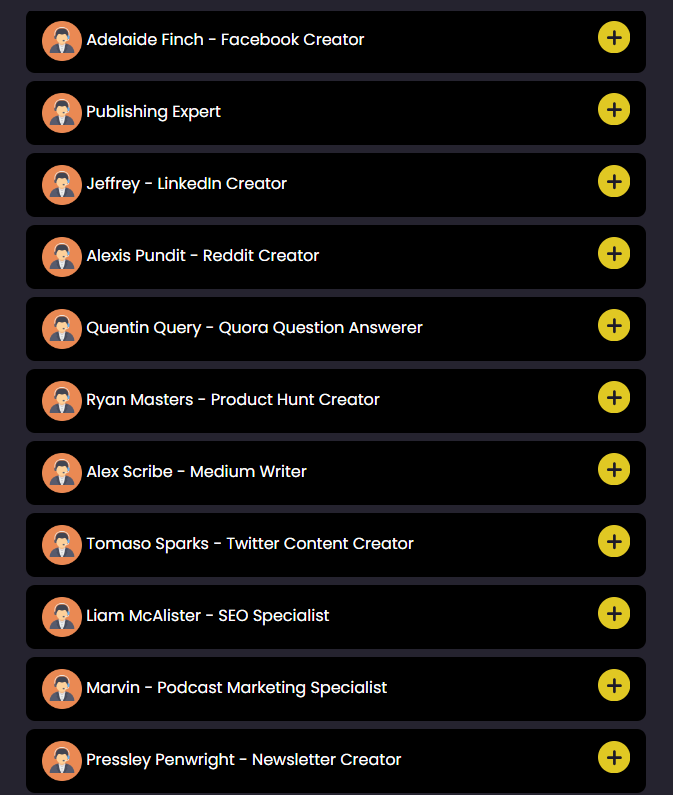So you think you know how ChatGPT works?
You’ve heard the buzzwords: AI technology, neural networks, language models — you’re no stranger to tech jargon.
But when it comes down to it, do you really understand what’s going on under the hood of this text-generating titan?
Can you explain why ChatGPT can draft an email (or a story, or an essay, or a summary, and more) that sounds eerily like something your buddy would write? Or Edgar Allen Poe? Or a cowboy from an old Western film?
How does ChatGPT do what it does?
Let’s dive into the world of GPT and explore how ChatGPT works in all its intricate glory.
Table of Contents
What is ChatGPT: An Overview
ChatGPT is an AI application whose core lies in the Generative Pre-trained Transformer (GPT) language models. This enables the app to perform tasks ranging from drafting emails to translating natural language into code.
What does ChatGPT stand for?
Chat: The primary use case of ChatGPT is to engage in natural language conversations.
Generative: ChatGPT can generate human-like text responses.
Pre-trained: The language model is initially trained on a diverse dataset to learn language patterns and contexts before fine-tuning for specific tasks.
Transformer: Refers to the underlying neural network architecture known for its effectiveness in handling sequential data and capturing long-range dependencies.
With an impressive 175 billion parameters, the neural structure of GPT-3 gives it a remarkable ability to generate human-like responses from simple language prompts.
And now GPT-4 is here, trained on a whopping 45 gigabytes of text and code, and can generate text, translate languages, write different kinds of creative content, and answer your questions in an informative way.
Let’s look at some key differences between the two models.
GPT-3
- Parameters: 175 billion
- Training data: 17 gigabytes
- Modality: Unimodal (text only)
- Good at generating creative text formats
- Can follow instructions and complete requests thoughtfully
- Can answer open-ended, challenging, or strange questions
GPT-4
- Parameters: 100 trillion
- Training data: 45 gigabytes
- Modality: Multimodal (text and images)
- More factual and accurate
- Better at understanding and generating different dialects
- Can respond to emotions expressed in the text

Where does ChatGPT get its data?
The training process of ChatGPT involves exposing it to approximately 500 billion “tokens” sourced from various corners of the internet. This vast dataset equips ChatGPT with a wide range of knowledge, enabling it to answer questions with contextually accurate responses.
Reinforcement learning plays a crucial role in refining ChatGPT’s capabilities. It learns how actions lead to rewards or penalties and leverages this feedback loop to continuously improve its performance over time.

ChatGPT now receives close to 30 million visits daily, according to data from Similarweb
When did ChatGPT come out?
ChatGPT made its debut on November 30, 2022, and it has been turning heads ever since.
After only five days since its launch, ChatGPT surpassed 1 million users. Two months later, in January 2023, ChatGPT had breached the 100 million mark — making it the fastest-growing consumer software app of all time.
On its first anniversary, ChatGPT has reached 1.7 billion people users.
ChatGPT is free for public use, marking a significant leap forward in conversational AI technology.
This language model has changed the way we think about interacting with machines, transforming our personal lives and revolutionizing industries.
ChatGPT is credited as the catalyst for the AI boom, sparking continuous and unparalleled advancements in the realm of artificial intelligence.
Who Owns ChatGPT?
This AI research lab has a reputation for pushing boundaries in machine learning and artificial intelligence.
Their focus on developing friendly AI plays a huge part in their work, including projects like ChatGPT.
Silicon Valley bigwigs back OpenAI financially and intellectually, making it quite the powerhouse.
Elon Musk and Sam Altman are among the high-profile names who founded OpenAI.
In 2024, they made an interesting move by creating a capped-profit arm called OpenAI LP.
This model lets them raise funds while sticking to their mission of ensuring AI benefits all of humanity.
Back in 2019, tech giant Microsoft invested $1 billion in OpenAI which was seen as nothing more than a regular corporate venture funding. With the explosion of ChatGPT, Microsoft bumped its investment to a whopping $10 billion, giving OpenAI a valuation of roughly $29 billion.
How Does ChatGPT Work in Natural Language Processing?
Natural language processing or NLP is what enables digital assistants to predict user input and online translators to quickly convert languages — all through the power of language models.
In simple terms, these models act as probability predictors for sequences of words. They have been designed with intricate algorithms that generate text by guessing which word might follow based on previous ones. Learn more about NLP from IBM Cloud Education.
The heart of ChatGPT’s magic lies in its training data. Think of a colossal library filled with books, articles, and internet content that this tool absorbs to learn human-like text generation.
As we mentioned earlier, the GPT-3 model was trained on around 500 billion tokens and has approximately 175 billion parameters within its neural network. Now imagine this enormous data power being used to generate paragraphs or even complete articles resembling human writing style.
To put this in perspective, consider that there are billions of human-written pages on the public web alone. Factor in non-public web pages, and you’re looking at numbers 100 times larger! That’s not even considering other sources like digitized books or spoken words in videos.
This broad dataset lets GPT models pick up not just grammar rules, but also real-world facts and cultural subtleties — making them more effective in producing meaningful content.
Digging deeper into how it processes large amounts of information reveals deep learning techniques at play. Imagine neural networks operating like our brain does — recognizing patterns within complex datasets.
In essence, deep learning and neural networks in ChatGPT work hand-in-hand to build artificial intelligence models capable of understanding language intricacies. This marvel is made possible by intricate algorithms using mathematical calculations to establish connections between words or phrases.
As these relationships get clearer over time, so too does the AI’s knack for producing coherent responses based on input cues.
Machine Learning and Neural Network Training
Machine learning and neural networks play a crucial role in the functioning of ChatGPT.
Training a neural network is similar to teaching a child through examples. Instead of explicitly programming it to recognize specific features, we provide it with a large number of images and let it learn from them. This enables ChatGPT to generalize beyond the training examples and understand concepts like “what is a cat” or “what is a dog.”
During training, weights are assigned to the neural network based on given examples. This allows the network to reproduce the desired outputs and interpolate (insert words or text) between instances effectively. This forms the core function of AI chatbots like ChatGPT.
With advancements like GPT-4, the power of neural networks has increased, enabling more efficient performance in complex tasks. For example, OpenAI’s Whisper technology has streamlined audio transcription, saving time and resources.

Source: Towards Data Science
Beyond Basic Training
When it comes to understanding how Chat GPT works, there’s a lot that goes on behind the scenes. After raw training, the neural network within ChatGPT starts generating its own text based on the prompts provided.
While these results may seem reasonable initially, they tend to veer off in non-human-like ways over longer pieces of text — a phenomenon easily noticed by human readers but not detectable through traditional statistical methods.
To help ChatGPT produce more human-like output, an additional step was introduced: active interaction with humans. In this phase, humans interact with ChatGPT and rate its responses — essentially providing feedback on what makes a good chatbot.
This feedback is then used in conjunction with another neural net model designed specifically for predicting those ratings. By running this prediction model like a loss function on the original network, it effectively tunes up the system based on given human feedback.
Semantic Grammar and the Power of Computational Language
Creating meaningful human language was once thought to be a feat only achievable by the human brain. However, ChatGPT’s impressive features have challenged this notion. ChatGPT works based on GPT-3’s neural network, which mirrors processes in the human brain, enabling it to produce coherent text data.
The success of ChatGPT reveals that there is more structure and simplicity in meaningful human language than previously understood. This revelation stems not only from syntactic grammar rules but also from semantic ones.
In syntax, we identify parts of speech such as nouns and verbs. However, semantics requires finer gradations, such as identifying concepts like “moving” or an “object.” Semantic rules may state that objects can move, reflecting a simple rule that captures complex reality.
What sets ChatGPT apart is its ability to not only produce grammatically correct sentences but also provide contextually relevant responses. This remarkable capability is a result of years of refining and continuous learning, allowing ChatGPT to extract coherent information from its vast knowledge base.
How Does ChatGPT Work: A Step-by-Step Breakdown
At a high level, ChatGPT is a language model that uses a variant of the Transformer network architecture, specifically Generative Pre-trained Transformer (GPT). It is designed to understand and generate human-like text based on the input it receives.
Here’s a step-by-step breakdown of how ChatGPT works:
- Pre-training: ChatGPT is initially trained on a massive amount of text data from the internet. It learns grammar, facts, reasoning abilities, and some level of common-sense reasoning. During this phase, the model learns to predict the next word in a sentence given the preceding words. The core concept behind GPT is the Transformer architecture, which consists of attention mechanisms that allow the model to weigh the importance of different words in a sentence.
- Tokenization: The text is broken down into smaller units called tokens. These can be as short as one character or as long as one word. For example, the sentence “ChatGPT is great!” might be tokenized into [“Chat”, “G”, “PT”, ” is”, ” great”, “!”].
- Contextual Understanding: ChatGPT processes input text in a way that understands the context of each token within the larger text. It assigns each token a contextualized representation that encapsulates its meaning relative to the rest of the text.
- Generating Responses: When you input a prompt to ChatGPT, it uses the contextual understanding it has developed during pre-training to generate a coherent response. It predicts the next word based on the context of the conversation and the prompt you provided. This is done by iteratively generating one token at a time, considering the preceding tokens as context.
- Fine-tuning: After pre-training, the model is fine-tuned on a narrower dataset that’s generated with the help of human reviewers. These reviewers follow guidelines provided by OpenAI to review and rate possible model outputs for a range of example inputs. The model generalizes from this feedback to respond to a wider array of user inputs.
- User Interaction: When a user interacts with ChatGPT, the model takes the user’s input, processes it, and generates a response based on the context of the conversation. The model doesn’t have true understanding or consciousness; it’s simply generating text that it has learned from its training data.
- Adapting to User Input: ChatGPT’s responses are influenced by the patterns it has learned from its training data, both during pre-training and fine-tuning. It doesn’t have personal experiences, emotions, or beliefs. It generates responses based on probabilities learned from the data it was trained on.

Source: OpenAI
How to Use ChatGPT
Talking with ChatGTP is like having a chat with your smartest buddy who knows a little about everything.
You type in something you’re curious about, and it hits back with info as if it’s read every book on the shelf.
But let me tell you how to really get the most out of this digital Einstein.
To start off, head over to OpenAI’s website or wherever ChatGPT lives these days.
Create an account if needed; they’ll just ask for some basic details — nothing too scary.
Once you’re in, there’s a big ol’ text box waiting for your queries — or cries for help on homework.
These are called prompts.
Prompts are where the magic happens. Think of them as keys that unlock different parts of ChatGPT’s brain.
The trick is being specific: “Tell me about blackholes” versus “Explain why blackholes aren’t just cosmic vacuums.”
The more precise your prompts are, the better stuff it throws at you.
Make It Personal
Sometimes, generic answers just don’t cut it — you need advice tailored to your life’s twists and turns.
Luckily, ChatGPT can do personalization like no other AI I’ve met before. It adapts its responses based on what you tell it. This means that whether planning trips or picking up new skills, getting bespoke tips from this bot feels surprisingly human-like — just without any awkward small talk.
Fine-Tuning for Accuracy and Relevance
Sure, GPT has brains, but sometimes even valedictorians get things wrong. When that happens, do not hesitate to ask follow-up questions or clarify details. A little nudge can steer the conversation back on track like a GPS rerouting you mid-drive.
Putting AI Ethics Into Practice
Now this is big: while using ChatGPT, remember that how you use its responses matters.
Be mindful of privacy concerns and always consider the source before passing information along as fact.
Think twice, act wise. Your digital footprint has more impact than you might realize.

What Can ChatGPT Do?
There are many uses of ChatGPT.
One of the most striking features of ChatGPT is its ability to emulate different writing styles. Whether you need a piece written in the style of your favorite author or require lyrics for an upcoming song, ChatGPT can deliver. Machine learning allows it to understand and replicate diverse writing patterns.
Apart from creating engaging content, ChatGPT also excels at following instructions. This makes it not just an information source but a practical tool for task execution. For instance, if you need to write code or create outlines for articles or novels, this AI chatbot could prove invaluable.
The potential uses are virtually limitless given that any task requiring written text response falls within its scope. It’s like having your assistant ready to handle varied assignments efficiently and effectively.
- Creative Writing: Generate poems and short stories tailored according to specific styles.
- Coding Assistance: Get help writing code snippets across multiple programming languages.
- Paper Drafting: Create comprehensive outlines for academic papers or business reports.
ChatGPT is also redefining how we think about customer service. It acts like a tireless team member who never sleeps, providing support 24/7. For consumers, chatbots mean no more waiting to get connected to a human agent, with AI ready to answer product or billing questions in an instant.
In education, ChatGPT helps students with homework and even aids teachers in creating lesson plans. One prominent UK private school recently altered its homework approach due to the rising influence of ChatGPT. Such changes highlight how educators worldwide are leveraging AI tools to enhance teaching methodologies and student engagement.
Thanks to its awesome language translation skills, ChatGPT is also breaking down traditional barriers to learning new languages.
If you’re thinking about healthcare, yes—ChatGPT lends a hand there too. It gives patients advice when doctors aren’t around. One study even shows promise in using conversational chatbots in mental health scenarios.
In the realm of journalism, content creators like BuzzFeed writers are witnessing an influx of AI-generated articles. Although this development brings about mixed feelings — excitement at technological progress and disappointment due to potential job displacement — it nonetheless signifies how deeply embedded AI has become in our lives.
The reach of what ChatGPT can do stretches across industries, and we’ve only scratched the surface here.
Limitations of ChatGPT
One of the key limitations of ChatGPT is the potential for biased or harmful content in its responses. This is because the model is trained on vast amounts of text data, which can reflect the biases present in the training material. OpenAI is actively working to minimize these biases through algorithmic adjustments and moderation policies.
Additionally, ChatGPT has a constraint in updating information beyond its last training cut-off point in January 2022. This means that any events or developments occurring after this point will be unknown to the model.
Another challenge for ChatGPT is handling complex topics where the relationships between words are not well-defined. In such cases, the model may produce irrelevant or nonsensical responses, as it relies on patterns observed during training rather than a true understanding of context.
Specifically, ChatGPT struggles with sarcasm and humor which are often highly contextual and nuanced aspects of communication. While one of ChatGPT’s big features is its capacity for generating realistic dialogues based on prompts from users, it doesn’t always succeed when those conversations become more complicated or involve multiple layers of meaning.
Another limitation lies in content generation, specifically writing articles. Despite GPT models’ proficiency at processing large volumes of text data and their impressive mimicry skills, they still lack nuance and depth when crafting long-form content.
Know more about what ChatGPT cannot do in this detailed guide about ChatGPT limitations.
Generalized AI vs Specialized AI
While ChatGPT is great for everyday tasks such as writing emails, summarizing text, and answering questions, it is not built for marketing and SEO which entails deep keyword research, competitive analysis, long-form content creation, and personalized messaging. If these are areas you wish to automate, then BrandWell is a better option.
BrandWell was created by marketers for marketers — purposely designed to create humanlike content that converts. It also doesn’t require complex prompting like ChatGPT does. All you need to do is enter a seed keyword if you want to do keyword research, generate topic reports, create a blog outline, and write a full 3,000-word blog post.
BrandWell also features a full suite of SEO tools to help you optimize your article, including SEO/NLP scoring, content audits, plagiarism scanning, and AI detection.

BrandWell also has a generative AI stack which includes the super smart chatbot AIMEE plus AI Agents that are trained in specific marketing tasks such as writing social media posts, ebooks, sales letters, ad copies, and more.

Plus, it offers a Bulk Undetectable Rewriter that fixes icky ChatGPT content in minutes! Scan up to 60,000 words at a time and “humanize” sentences and paragraphs in one go.
BrandWell is brand growth made easy. It’s your entire content marketing process, on autopilot.
The Tech World’s Response to ChatGPT
ChatGPT has made a significant impact on the tech industry. Thanks to its neural network which closely resembles the human brain, ChatGPT can deliver impressive results.
One of the notable features of ChatGPT is its ability to generate relevant content on demand. Users can utilize ChatGPT for various tasks, such as coding development or writing real estate listings. This showcases the versatility of this tool when integrated into different workflows.
Leading companies like Microsoft have recognized the potential benefits of using AI tools like ChatGPT. They not only encourage their employees to utilize these tools but also actively participate in refining ChatGPT’s capabilities through continuous interaction.
Real-World Applications of ChatGPT
It’s hard to contain the excitement when discussing large language models like GPT-3 and GPT-4. The impact they’re making in various sectors is nothing short of groundbreaking. They are examples of neural nets that can be trained to perform tasks by learning from specific instances and then generalizing those learnings.
And because ChatGPT is free to use, 30 million people are now using it daily to perform different tasks.
In education, these AI models have ushered in a new era where students can grasp complex subjects with relative ease. Picture this: A student poses a question, and the model generates an explanation or tutorial tailored specifically for them. That’s pattern recognition at its finest.
Their capabilities don’t stop there; grading assignments or exams becomes less burdensome as these tools recognize patterns between correct answers versus incorrect ones — quite revolutionary for educators everywhere.
Chatbots like Khan Academy’s Khanmigo platform even offer personalized tutoring experiences for students worldwide.
A key industry that has harnessed this tech marvel is marketing. By integrating ChatGPT API, marketing teams can write sales letters, product descriptions, and social media posts within minutes — saving time and resources.
We also see ChatGPT helping overcome communication barriers through translation services. By understanding context and nuances within languages, this artificial intelligence tool helps connect people globally through language translation.
This model has an uncanny knack for recognizing patterns in human-like ways which enables accurate translations across numerous languages – something once thought impossible without extensive human intervention.
In business, AI bots are capable of handling high volumes of customer inquiries while maintaining a personal touch usually associated with humans. As such applications become more prevalent, companies could potentially reap significant operational efficiency gains alongside improved customer satisfaction levels.
Curious how you can use ChatGPT? Read our complete guide on the many uses of ChatGPT in various industries.
The Impact of ChatGPT on Jobs
The rise of AI systems like ChatGPT has the potential to reshape the global job market. According to a report by Goldman Sachs, around 300 million full-time jobs worldwide could be impacted by such technologies.
Roles in administrative and legal sectors are particularly vulnerable due to their reliance on text data that can be easily processed by GPT language models like ChatGPT. The integration capabilities offered through the ChatGPT API make it a versatile tool across different industries.
However, it’s important to note that AI will not completely replace human labor. AI is not going to take your job, but someone who knows how to use AI might. This highlights the growing trend of companies looking for individuals who are skilled in leveraging AI tools for various applications.
This shift towards automation also creates new opportunities in tech-centric roles that require proficiency in advanced machine learning frameworks like ChatGPT.
Ethical Considerations in the Age of Conversational AI
ChatGPT, like any powerful tool, wields a great deal of influence.
It shapes conversations and provides information at lightning speed.
But with such capabilities come significant ethical considerations we can’t ignore.
The Privacy Puzzle
Talking to ChatGPT feels like chatting with a friend who never forgets what you say.
This raises real privacy concerns because everything shared could potentially be stored or analyzed later on.
To learn more about data privacy, take a look at OpenAI’s usage policy.
Bias: The Invisible Hand in AI Responses
A conversational AI is only as unbiased as the data it’s fed.
And let’s face it — our world isn’t free from biases.
Since ChatGPT learns from the vast sea of online content, it can inadvertently reflect the biases present in that data and perpetuate stereotypes unless carefully monitored.
For insight into bias in technology, give this article from IBM a read.
Misuse and Abuse
Concerns about misuse also loom large. As ChatGPT becomes more capable, there’s a need for vigilance to prevent malicious use or the propagation of harmful content.
Striking a balance between enabling innovation and ensuring safety is a tightrope walk in the world of AI ethics.
OpenAI acknowledges these challenges and actively seeks input from the user community to shape its policies. The deployment of safety mitigations, the implementation of usage policies, and ongoing improvements are part of OpenAI’s commitment to responsible AI development.
Societal Impact: Weighing Convenience Against Consequences
Conversational AIs offer convenience but also risk reducing human interaction and job opportunities.
To grasp these societal shifts better, the Data & Society Research Institute offers thought-provoking perspectives on artificial intelligence’s role within society.
So, while we’re blown away by how ChatGPT can talk, it also nudges us to think about the ethical side of AI. It’s not just what tech can pull off, but how do we make sure it plays nice with our values and beliefs? It’s a conversation that’s crucial for shaping a future where AI benefits society ethically and responsibly.
The Future of ChatGPT and Generative AI
Imagine a world where your digital assistant doesn’t just understand what you say, but also grasps the emotion behind your words.
The future of conversational AI like ChatGPT looks promising and is bound to push boundaries even further.
Predictive Personalization at Its Best
A leap ahead might see ChatGPT predicting needs before we voice them out loud. This could mean anticipating questions based on context or past interactions and offering help that feels almost telepathic.
Say goodbye to robotic responses because as natural language processing evolves, so will the fluidity of conversation with AIs. Think less ‘AI’ and more ‘human-like companion.’
Bridging Language Barriers Globally
Chatbots may become our personal translators in real-time conversations, breaking down global communication barriers. They’ll offer instant translation services that feel seamless and natural, making international business smoother than ever.
This goes beyond text-based chats; imagine having a spoken dialogue with someone speaking another language while AI translates on the go. It’s like having an interpreter in your pocket.
Ethical Programming Takes Center Stage
As these language models advance, ethical programming will take center stage to ensure fairness and unbiased assistance for all users.
We’re looking at developers embedding moral codes within AI systems — think virtual ethics committees ensuring every interaction aligns with societal values. This means creating algorithms that respect privacy and promote equality across various user demographics.
The Merging of Digital Realms
Moving forward into uncharted territories might bring us closer to merging digital realms through augmented reality (AR) experiences guided by conversational AIs like ChatGPT.
Think about asking for directions and seeing arrows laid over the real world while chatting naturally with your guide — that’s where we’re headed.
FAQs – How Does ChatGPT Work?
How does ChatGPT work?
Chat GPT operates on a transformer-based machine-learning model. It uses patterns in the data it was trained on to generate human-like text responses, adapting its output based on user input.
Does ChatGPT use the internet?
According to OpenAI, Chat GPT is not connected to the internet. It also has limited knowledge of world events after January 2022 which is why it may occasionally produce incorrect, harmful, and biased responses.
Does ChatGPT give the same answer to everyone?
When different users ask the same questions, Chat GPT generally gives similar answers. While there may be slight variations in wording due to the complexity of GPT language models, the overall responses remain consistent.
Can I use ChatGPT without the Internet?
While the primary mode of using Chat GPT requires an active internet connection, there are ways to run similar language learning models (LLMs) on your PC offline.
To accomplish this, you would need to install programming languages like Python and Node.js along with C++. However, it’s important to note that while these installations may allow for some form of text generation or interaction, they won’t be able to replicate all of ChatGPT’s key features.
Can people detect if you use ChatGPT?
Detection depends largely on how well ChatGPT’s responses align with the context of the conversation. While advanced users may notice certain signs, many interactions can appear convincingly human.
If you want to publish 100% undetectable content, run your text through BrandWell’s AI detector tool. This industry-leading software boasts a 98% accuracy in predicting whether your text is written by a human or AI.
What is the best way to use ChatGPT?
The optimal usage of Chat GPT varies per task but generally involves providing clear instructions and using system-level tweaks for fine-tuning response characteristics.
Conclusion
ChatGPT is a marvel of AI, an intricate weave of neural networks and reinforcement learning.
This text-generating powerhouse has its roots in language models like GPT-3 and GPT-4.
The secret sauce? A hefty dose of natural language processing and large-scale training data.
But it’s not just about how does ChatGPT work. It’s also about the real-world impact these technologies are making.
From writing draft emails to translating code, they’re transforming our digital landscape.
Yet, such great power carries a hefty obligation. We must grapple with ethical considerations while harnessing this cutting-edge tech for good.